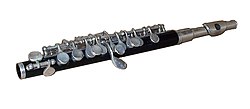Piccolo: Difference between revisions
fixed spelling mistake that resulted in nonexistent hyperlink |
|||
| Line 39: | Line 39: | ||
* [[Rossini]] Semiramide, La gazza ladra, La scala di sieta |
* [[Rossini]] Semiramide, La gazza ladra, La scala di sieta |
||
* [[Shostakovich]] Symphony Nos. 5,6,7,9,10 |
* [[Shostakovich]] Symphony Nos. 5,6,7,9,10 |
||
* [[ |
* [[Tchaikovsky]] Symphony No. 4 in F minor |
||
==Traditional use== |
==Traditional use== |
||
Revision as of 22:22, 26 October 2008
 | |
| Classification | |
|---|---|
| Playing range | |
 | |
| Related instruments | |
The piccolo is a small flute. Similar to its larger counterpart, the piccolo has the same fingerings but sounding an octave higher than written. The piccolo is often one of the highest instruments within the orchestra or band. Now only manufactured in C they were once made in D-flat during Sousa's time. Notorious is the Scherzo from Tchaikovsky's Symphony No. 4 in F Minor, the piccolo has one of the most technically challenging solos lasting only for 2 seconds total (This is preceeded by taceting the first two movements). In the orchestral setting, the piccolo player is often designated as Piccolo/Flute III or even Assistant Principal. The larger orchestras have designated this position as a Solo position due to the demands of the literature.
Timbre and construction
Because the piccolo's sound is in a high register, it has a potential to be strident or shrill. There has been an increase in recent years for the solo literature, led by former St. Louis Symphony Orchestra piccoloist Jan Gippo. While there are not many concertos composed for the piccolo, there are three notable composers Lowell Liebermann, Antonio Vivaldi, and Bruce Broughton. (Vivaldi’s Concerti (2 in C Major and 1 in A minor), however, were originally for the sopranino recorder).
Unlike the flute, the piccolo has a conical bore (tapering towards the end of the instrument) where the flute is cylindrical, the same width throughout.
It is difficult to sustain notes softly in the third octave.
The piccolo has a stereotype for being difficult to play in tune (How do you get 2 Piccolos to play in tune? Shoot one.); its small size makes it difficult to construct an evenly tuned scale.
Piccolos may be constructed out of wood, silver, gold, plastic, or a combination. Many piccolo players find that wooden piccolos offer a more mellow timbre than metal ones. In more recent years the piccolo has also been made out of a plastic composite material. The composite piccolo is durable enough for marching and produces a fair quality sound. Most professionals agree that a piccolo should be made out of only one material, as two separate materials with different coefficients of thermal expansion lead to tuning inconsistencies.
Major Solo Works for the Piccolo
Antonio Vivaldi: Piccolo Concerto in C major, RV 443
Bruce Broughton: Concerto for Piccolo and Orchestra
Lowell Liebermann: Concerto For Piccolo And Orchestra, Op. 50
Major Orchestral Works for Piccolo
- Bartòk Concerto for Orchestra; Movement III "Eligia"
- Beethoven Symphony No. 9 in D minor
- Rossini Semiramide, La gazza ladra, La scala di sieta
- Shostakovich Symphony Nos. 5,6,7,9,10
- Tchaikovsky Symphony No. 4 in F minor
Traditional use
Historically the piccolo had no keys, but does today, and should not be confused with the fife, or classical piccolo, which has a smaller bore and is therefore more strident. The piccolo is used in conjunction with marching drums in traditional formations at the Carnival of Basel, Switzerland. The piccolo was originally made out of wood and was featured in many prominent composers works. One of the earliest pieces to use the piccolo was Beethoven's Symphony No. 5 in C Minor, only playing during the final (IV) movement.
Book sources
- Kennan, Kent Wheeler. The Technique of Orchestration New York: Prentice-Hall Inc., 1952: 88 - 91
- Sadie, Stanley "Piccolo." The New Grove Dictionary of Music and Musicians, ed. Stanley Sadie, Vol. 19. NY: Oxford University Press, 2001.
- Munster, Peter van. Repertoire Catalogue for Piccolo, Alto Flute and Bass Flute. Roma: Riverberi Sonori, 2004
